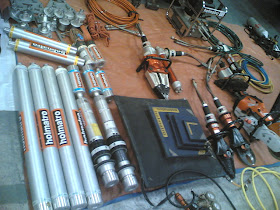Bonsai Forest in Mount Hamiguitan
Bonsai is a widely popular and quite expensive pursuit of art form where specific species of trees suitable for bonsai development are meticulously cut and shaped to restrict its growth; with its crown defoliated, and root pruned, and grafted periodically to make them small and compact purposely to mimic the shape and style of mature, full-grown trees. It is an ancient art form that has become a tradition in Japan and other Asian countries. But, in the Philippines, particularly in Davao Oriental, Mindanao, Bonsai trees are naturally grown and shaped over time, untouched by human hands.
This unique wonder of nature can only be found in the lush forest of Mount Hamiguitan located within the boundaries of Mati, Governor Generoso, and San Isidro, Davao Oriental. Popularly known as "Bonsai Forest", it is the Philippines' largest and only protected forest noted for its unique bonsai field or 'pygmy' forest of outstanding universal value. It sits in an elevation of 5,345 feet above sea level, covering a sprawling area of almost a thousand hectares of 16 species of century-old bonsai trees of twisted trunks and branches that grow naturally to an average height of about 1.4 meters. The bonsai trees are very sturdy that one can literally stand over it without falling. Because of the rampant timber poaching, illegal logging, and over harvesting of forest products and resources, Mt. Hamiguitan and its vicinities was declared a protected area under the category of wildlife sanctuary and its peripheral areas as buffer zone by virtue of Republic Act 9303 on July 30, 2004.
Mount Hamiguitan is a declared protected area
The entire Mount Hamiguitan covers a land area of about 31,000 hectares and is home to many endemic, rare, endangered and economically important flora and fauna, and is part of the reason why the Philippines ranks seventh among the 17 biologically rich countries of the world that represent fast disappearing habitats of globally important species of plants and animals.
Mount Hamiguitan is considered ultramafic. It has a kind of soil that contains high level of heavy metallic compounds that makes it suitable for bonsai trees to grow naturally. Unlike other ultramafic forests in the Philippines, Mount Hamiguitan has several special and unique species of century old miniature trees.
Bonsai Tree at the peak of Mount Hamiguitan
Philippines' largest and only protected forest
noted for its unique bonsai forest of outstanding universal value
A typical form of a natural bonsai tree
about 1.4 meters tall, century old, twisted trunks and branches
Mossy-Pygmy forest
Hidden inside the thick bonsai forest are living trees that seem lifeless at a first glance due to its unusual branch structure and color. This plant community exists at the Mossy-Pygmy forest of Mount Hamiguitan.
This is one of the 10 amphibian species identified in Mount Hamiguitan
wherein seven of which are endemic to the Philippines
Nepenthes Peltata
Nepenthes Peltata is one of the three tropical pitcher plant species that can be found only in the upper slopes of Mount Hamiguitan. It is a plant species endemic only in the Philippines and cannot be found anywhere else in the world.
Full grown pitcher plant
Full grown orchid
Almaciga Bonsai Tree
Shown in above photograph is a full grown but waist-high Almaciga (Agathis philippinensis) bonsai tree which is already bearing fruit. Normally, Almaciga grows at a height of 15 meters or so at its natural habitat with a diameter cannot be embraced by two persons joining hands together.
Tinagong Dagat (Hidden Sea) is situated a thousand feet above sea level, atop Mount Hamiguitan. The site is uninhabited and considered as one of the most puzzling phenomena of nature; a mysterious lake having high and low tide cycles as if a sea rises in the mountain - only in Mount Hamiguitan.





























































